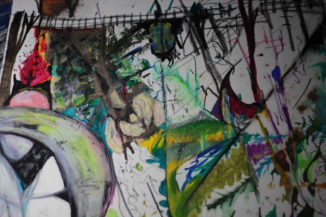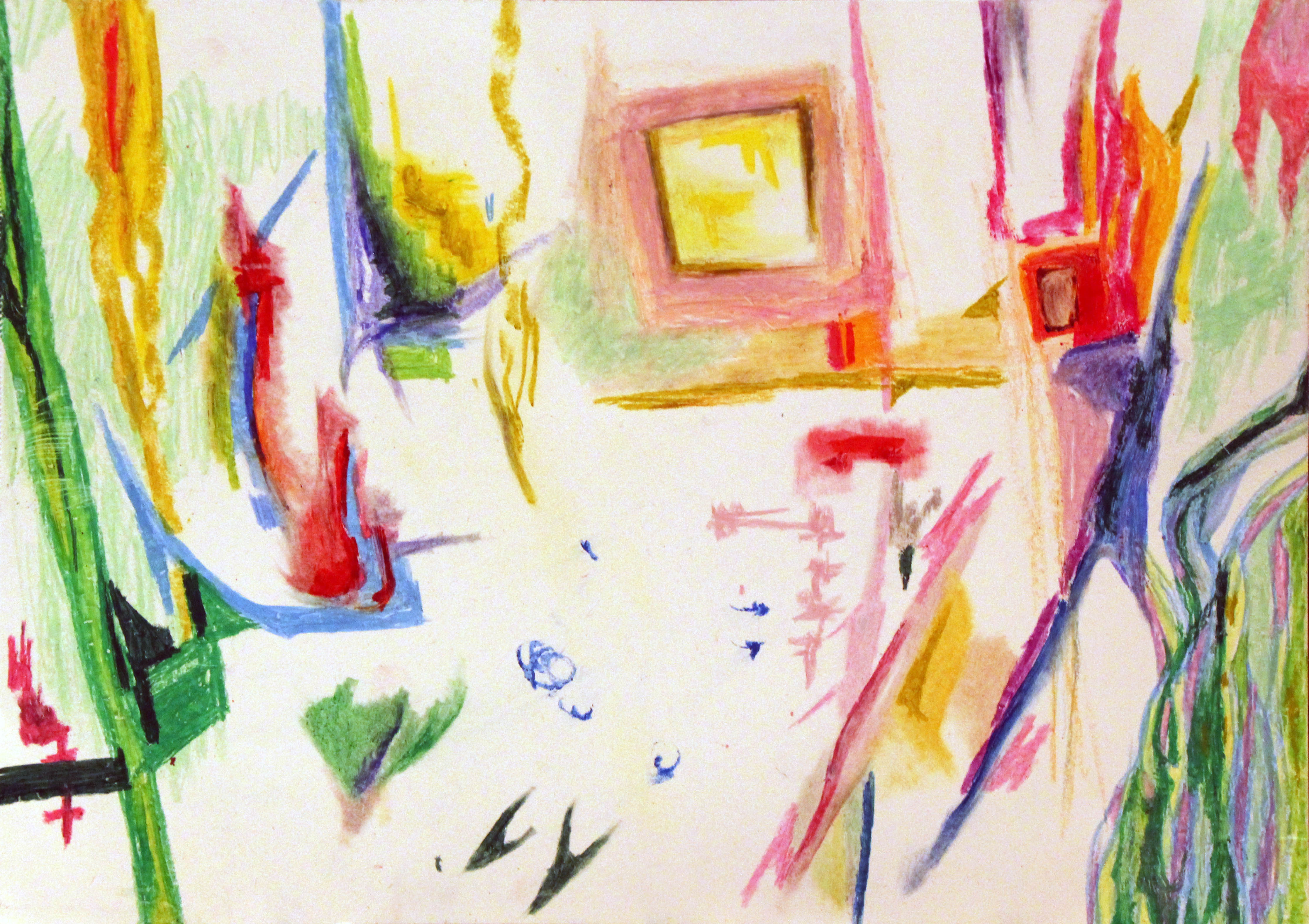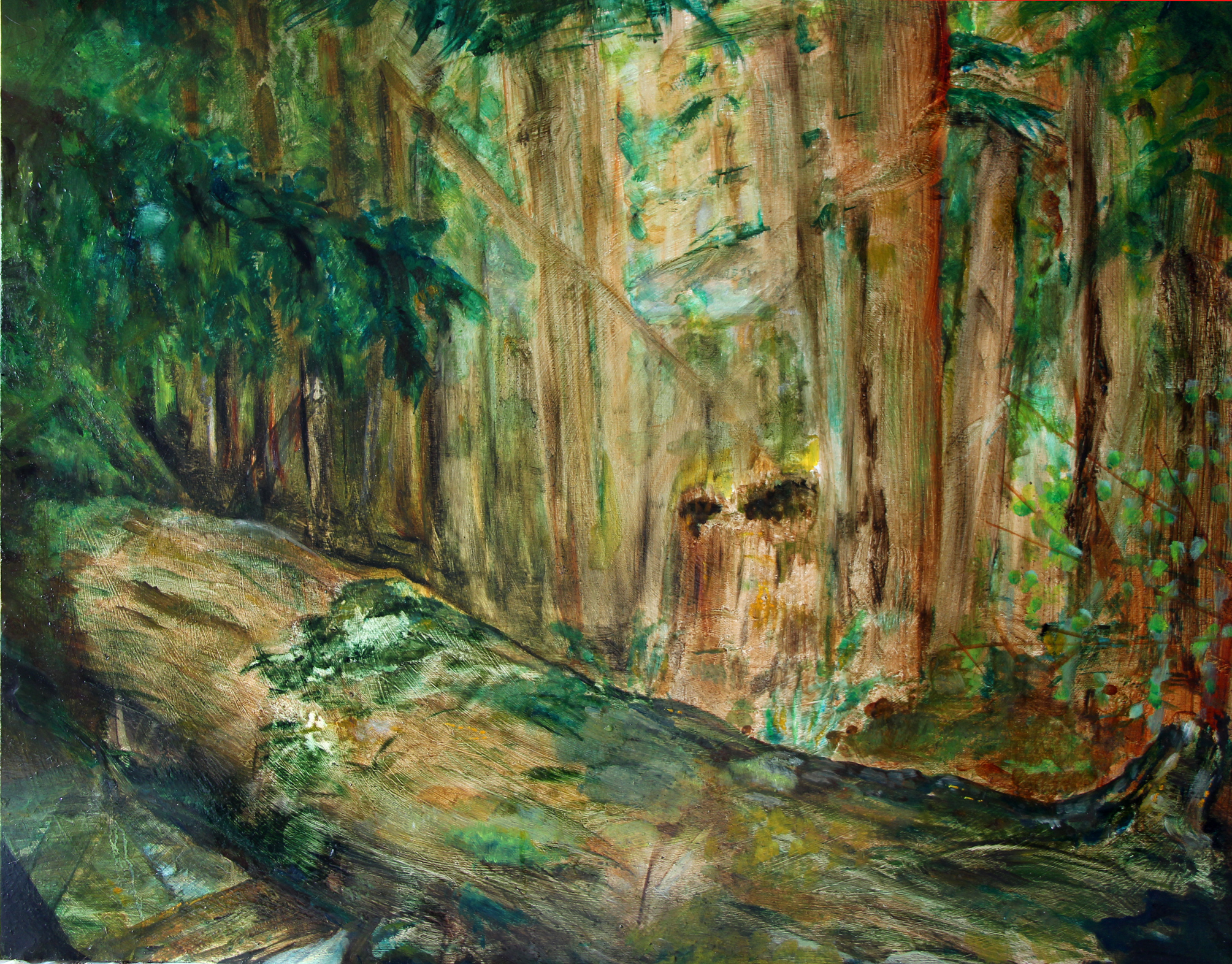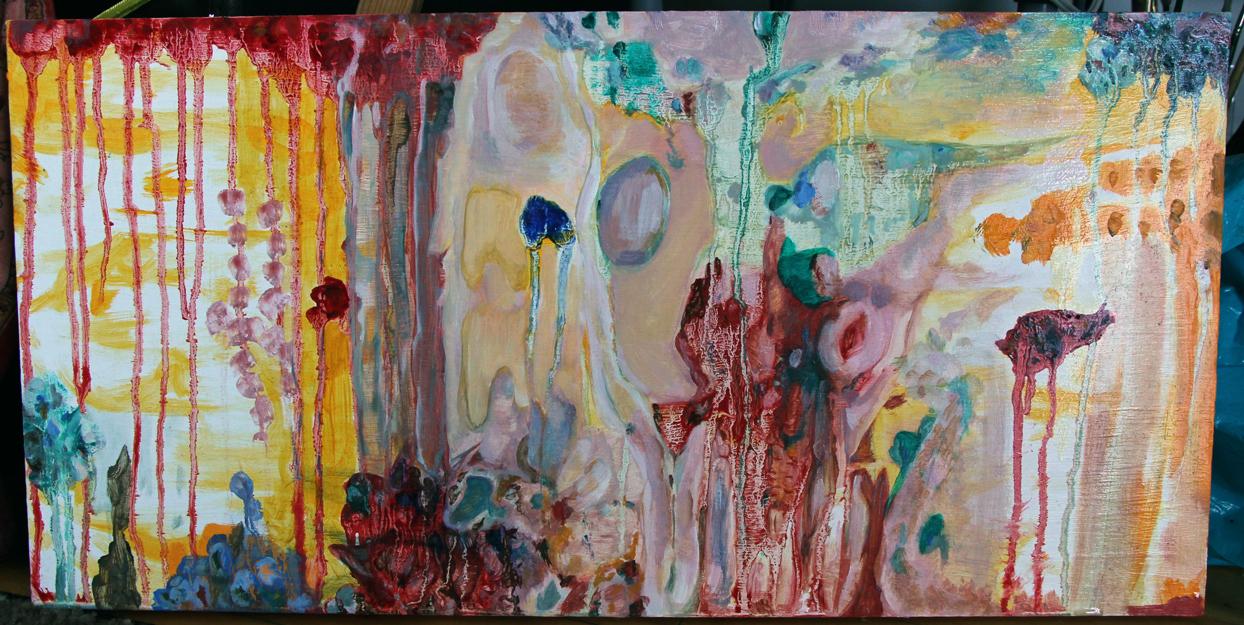newly recognize occupations of physical and imaginative terrain upon which i build my relations to self & worlds
construct forest thematic and geometry, return to fractured microcosms with new questions ~//[\\~,+<<|>


As I have been listening to field recordings, reading, and writing for my thesis over the last year, I’ve been ‘decompressing’ in my down time by practicing automatic painting and drawing. It turns out even my spare time is obsessed with imagining space.
This is a series of oil pastel drawings in progress (I’m working across them, so they’re at different stages). It’s my first time really playing with pastels, and I’m enjoying the potency of their colour.
These imaginary matter-scapes are suggested by sound, light, and architectures (ruined and rising) of stories that cannot be collapsed into words.
When I was a kid I had trouble sleeping because when I closed my eyes at night, I started drifting or even flying into these colourful spaces behind my eyelids. They moved and pulsed in ways that felt full of meaning, but I could not translate.
I try to imagine being cellular and cosmic at the same time; one entity, yet many organisms; fixed and fluid. Every shift in focus makes a new scene without eradicating the last, multiplying tunnels that reconstruct the world at every scale.
[a little entity meets a bigger one: fiction from the simulation (excerpt)]
She told me that language didn’t work the same — when you uttered a word, you never uttered one word but layered hundreds, even thousands, of words at the same time. Uttered did not refer just to the voice, and words was only a rough translation. These were spatial forms with peaks and buttresses and funnels that doubled the in for the out, generating whirlpools of creation. Imagine mirrors that are also oceans, moving and rippling, invoking presence and absence in constant reconfiguration. In this atmosphere, through our breath (again a rough translation) meaning constellates and thunders in an eternal bloom. She was kind but clear: I would never experience even a fraction of the narrative, much less ‘understand’ it. No cross-section or snap-shot could ever express the whole. I was hanging, reverberating in a void blown open by our encounter. She had already forgotten me, and there was little chance I would meet one like her again.

I’m supposed to be sorting field recordings for my thesis project, but I decided to make a little audio portrait of my nephew Levi instead. While listening to my recordings I caught him being quietly thankful. Chips are the way to his heart. 23 seconds.



(i was trying to remember the types of trees and moss specifically through my visual memory and the surprise of my brushstrokes): i made this painting as part of a research-creation project reflecting on recollection of my visits to the forest sites where i’ll be listening and observing this summer (in this case, hoover lake, mission, british columbia). i’m trying to understand what i know about the public spaces in my hometown and why. what else could i know? what does my body know?
note: when i go back to the painting, i’ll fill the turns and spaces with surreal and psychedelic tangents; i can see some of those starting to force their way up through the cracks already, like the old plank road refracting itself in the bottom left corner

I worked on this painting (oil on wood) throughout January-February. It still needs glazing & the current version is a little more developed in one or two places on the left side.
Painting entrances me and relocates my thought-work; my moods and rumination, what I’m reading or eating, feed into my painting. Sometimes I prompt myself to ‘melt’ or ‘break open’ a certain space, or to juxtapose the big and little things that share space at different scales.
As with lots of my painting, I eventually plan to work with the camera and soundtracks to make them even more so into explorable spaces.

(Beast by Helena Krobath 2015; ink & gesso on wood)
I’ve been working sporadically on the main piece, Horrorland: Light on the Hill for several years; it consists of written vignettes and crossing stories, fables and visual images, diorama scenes, stage and costume, voice work, and vulnerability. Recently, I’ve added electroacoustic chapters developed in sound classes at Simon Fraser University.
The structure of this non-fictional fiction piece is loose and cross-tethered: it is an imaginary realm with sketches pinned to its walls and wind chimes hanging from the arches. I have found my own trauma to be cubist; it flickers and defies me, constructing itself from all angles–especially imaginary ones.
Sounds echo differently here. Stories mean multiple things, but the meanings keep shifting. It’s hard to trust my surroundings. I startle, I embody hysteria, I hide. Monsters emerge from my pen, my microphone, and my imagination, yet they always spill out as stories.
The trigger is a ghost, a constellation of the past through which my instincts configure the present. Traces and trajectories remain entangled in the world while I chase their tails. I reflect on them and disentangle, but they ghost on.
These two audio projects (Tooth and Claw and Oh My Mother) sought to express a mental condition and way of perceiving through story and sound. The idea of animating aspects of the memoir sonically came about directly as a result of sound studies classes in which I was amazed by what I heard as the power of sound to communicate states of mind through non-verbal imagery. I could also learn about the world and my own experience by noticing the role of sound.
Although I’ve been comfortable working with text and voice, I also wanted to process my collected and found sounds to suggest a material and mental space. When I come back to it next, I’ll take this project further from text-based narrative, and experiment with more sonic storytelling techniques. The story itself is unfinished (waiting for me to meet it from a new place).


I was excited to lead a tour for my first time with The Vancouver Soundwalk Collective and Vancouver New Music.
The walk was called ‘Parks, Trees, and Tankers,’ and it explored juxtaposing parks, residences, and heavy industrial/shipping/refinery operations along the shore of the Burrard Inlet across from the North Shore Mountains.
When I did the soundwalk in practice, the grain dispenser was going at the bottom of the path just east of the park. It completely changes the landscape with its drone and rumble. Luckily there were at least some trains on our way through the New Brighton Park.
Here are the handouts I made about soundwalking and the New Brighton area (general soundwalking prompts on one side, info about the region on the other)
Over millions of years, the region was shaped by eathquakes and continental folding, violent volcanoes that blew their tops and became mountainous islands in shallow seas; they gave rise to the rocks of the Coast Mountains, which existed under thick sheets of ice for millenia, marked by the slow grinding of glaciers and trickling rivers
“Burrard Inlet is in fact the drowned valley of a stream which drained the Indian River and Seymour River valleys…until the Capilano dam was built in the 1950’s, a dredge was needed to remove this sediment so that the channel could be kept open for ship traffic. Without man’s intervention, Burrard Inlet would soon turn into Burrard Lake” –John Armstrong, Vancouver Geological Society
A region inhabited and navigated by Musqueam, Sḵwxwú7mesh (Squamish), and Xwméthkwyiem (Tsliel-waututh) First Nations “…long before the ice had entirely disappeared…”
For thousands of years, First Nations people carried on trade and settlement along the coast. The Musqueam, Sḵwxwú7mesh (Squamish), and Xwméthkwyiem (Tsliel-waututh) First Nations culturally negotiated and occasionally fought over their use of the region. Traders traveled the Inlet by canoe, meeting at points to forage and hunt, including a popular spot in the area now known as “New Brighton Park”
… COLONIZATION, BC LAND PROCLAMATION,1859: All land in BC belongs to the Crown (says the Crown). British subjects can claim 160 acres of land aside from Native land (whose settlements measured at 10 acres per person) and Govt/Military reserves.1887: CPR (Canadian Pacific Railroad) Terminus in Vancouver: Industry explosion!
In the 1860s, New Brighton Park was briefly the site of a weekend resort for loggers, mill workers, and others on vacation from neighbouring areas
"Burrard Inlet and the Second Narrows" by Flying Penguin Licensed under CC BY-SA 3.0 (link)
Current Industry in Burrard Inlet: International Shipping/Processing/Refinery Terminals for Petroleum, Lumber, Fertilizer, Coal, Potash, Grain, Chemicals; Power plants; Ship repair; Cruise ship facilities; Parks & trails
Major oil spills happen periodically & gather immediate attention, but it’s worth pointing out that the waters are severely contaminated already with processing and shipping effluent. Several critical measures have been proposed by advocacy groups to rehabilitate the coastline of this area
NATURE in Burrard Inlet: Intertidal marine ecosystems: tide pools & tidal structures and action attract diverse organisms Sandy areas: home to borrowing animals, clams, oysters, birds
Land animals included black bear, deer, & gray wolf; certain animals live only in old growth forests (few of which remain); e.g., giant salamander, spotted owl. Urban-adapted animals include raccoon, coyote, skunk, swallows, brown bats. Dozens of fish species haved lived near shore and in kelp beds. Housing-created ecosystems foster species such as doves, sparrows, gray squirrels & rats
<<<<real estate connection?>>>>> New noise monitoring programs have been announced by Port Metro to deal with rising property values residential complaints along the waterfront